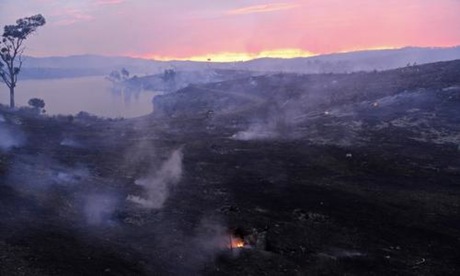
Australia could be on track for a temperature rise of more than 5C by the end of the century, outstripping the rate of warming experienced by the rest of the world, unless drastic action is taken to slash greenhouse gas emissions, according to the most comprehensive analysis ever produced of the country’s future climate.
The national science agency CSIRO and the Bureau of Meteorology have released the projections based on 40 global climate models, producing what they said was the most robust picture yet of how Australia’s climate would change.
The report stated there was “very high confidence” that temperatures would rise across Australia throughout the century, with the average annual temperature set to be up to 1.3C warmer in 2030 compared with the average experienced between 1986 and 2005.
Temperature projections for the end of the century depend on how deeply, if at all, greenhouse gas emissions are cut. The world is tracking at the higher emissions scenario, meaning a temperature increase of between 2.8C and 5.1C in Australia by 2090.
According to the report, this “business-as-usual” approach to burning fossil fuels is set to cook Australia more than the rest of the world, which will average a temperature increase of 2.6C to 4.8C by 2090.

Australia’s surface air temperature has already increased 0.9C since 1910, with the number of extreme heat records outnumbering extreme cool records nearly three to one since 2001.
Australia experienced its third-warmest year on record in 2014, with 2013 its warmest year on record. The heat experienced in 2013 was “unlikely” to have been caused by natural variability alone, the report stated, with such temperatures now five times more likely due to humans releasing greenhouse gases into the atmosphere.
Other findings of the wide-ranging analysis, the first such Australian climate projection made since 2007, included:
- The interior of Australia is set to warm more rapidly than coastal areas. Alice Springs will experience an average of 83 days a year over 40C in 2090, up from just 17 in 1995.
- Melbourne will swelter through an average of 24 days above 35C by 2090, up from 11 in 1995. Sydney will experience 11 days above 35C by 2090, an increase from three days in 1995.
- Australia is on course for a sea level rise of 45cm to 82cm by 2090, if emissions are not curbed. The report warned that if the Antarctic ice sheet was to collapse, sea levels would be a further “several tenths of a metre higher by late in the century”.
- Extreme rainfall events will increase but overall rainfall is expected to drop in southern Australia, apart from Tasmania, during the winter and spring months – by as much as 69% by 2090.
- There will be more extreme droughts, with the length of droughts increasing by between 5% and 20%, depending on how quickly greenhouse gases are cut.
- Rising temperatures will result in a “greater number of days with severe fire danger”. Meanwhile, soil moisture will fall by up to 15% in southern Australia in the winter months by 2090.
- Snow cover will decline, with the report stating there was “high confidence that as warming progresses there will be very substantial decreases in snowfall, increase in melt and thus reduced snow cover”.
These changes are likely to produce some benefits, such as enhanced agriculture in Tasmania and fewer deaths from cold weather. But they will be overshadowed by the negatives, such as rising numbers of deaths from heatwaves, water resource challenges, impacts upon agriculture and risks posed to coastal infrastructure by rising seas.
Some of the most profound transformations are set to take place in the seas that surround Australia, which will warm by a further 2C to 4C unless emissions are cut.
Excess carbon dioxide absorbed by the oceans causes the water’s pH level to drop. This acidification makes it more difficult for corals to form hard reef structures and other creatures such as oysters, clams, lobsters and crabs to develop their shells.
This phenomenon poses a major risk to ecosystems such as the Great Barrier Reef and is, according to the report, “likely to impact the entire marine ecosystem from plankton at the base to fish at the top”.
Kevin Hennessy, the principal research scientist at CSIRO, said the CSIRO and Bureau of Meteorology now had a greater confidence than ever in their forecasts of Australia’s climate.
“Australia will warm faster than the rest of the world,” he told Guardian Australia. “Warming of 4C to 5C would have a very significant effect: there would be increases in extremely high temperatures, much less snow, more intense rainfall, more fires and rapid sea level rises.”
Hennessy said even the internationally agreed limit of 2C of warming on pre-industrial times would cause severe problems for Australia.
“That intermediate emissions scenario would have significant effects for Australia,” he said. “Coral reefs are sensitive to even small changes in ocean temperature and a 1C rise would have severe implications for the Great Barrier Reef and Ningaloo reef.
“The situation is looking grim for the Great Barrier Reef unless we can significantly reduce greenhouse gas emissions. A 2C future would be very challenging.”
Hennessy said Australia should prepare for this altered climate by ensuring hospitals, transport infrastructure, construction codes and fire planning all considered the rising temperatures.
Cutting emissions would also help head off the worst of climate change, with nations set to convene in Paris later this year for crunch talks aimed at agreeing emissions reductions beyond 2020.
“Achieving that intermediate, rather than higher, emissions path would require significant reductions in global greenhouse gases,” Hennessy said. “It’s difficult to say what will be achieved, there are a lot of negotiations to come in Paris. We hope there will be an agreement until 2050 at least, but who knows what will happen in the coming decades.”
